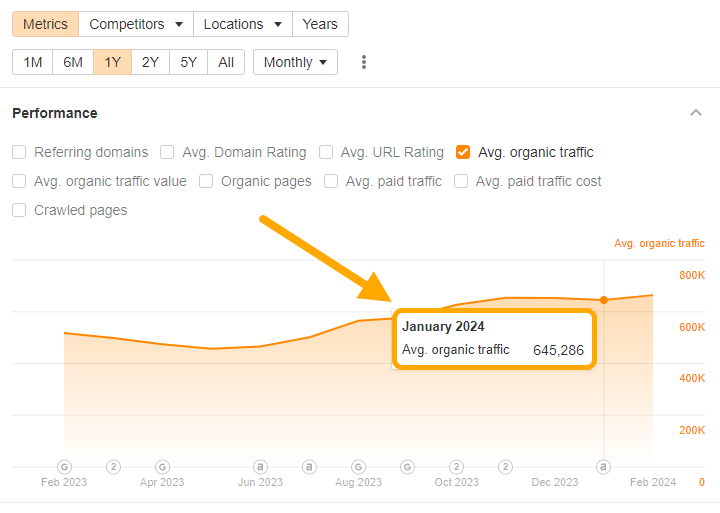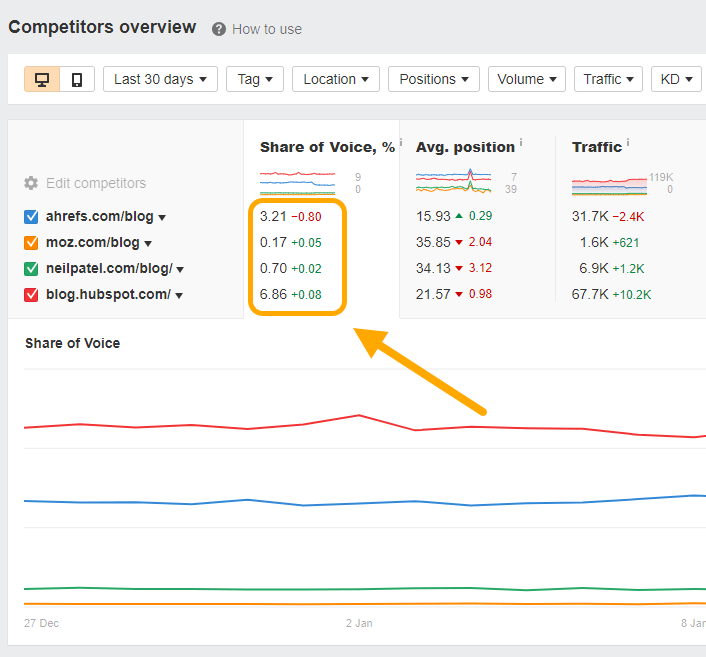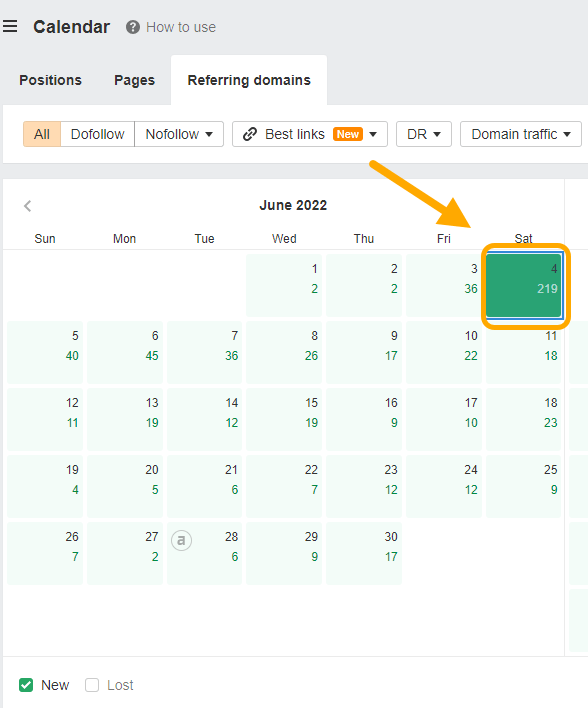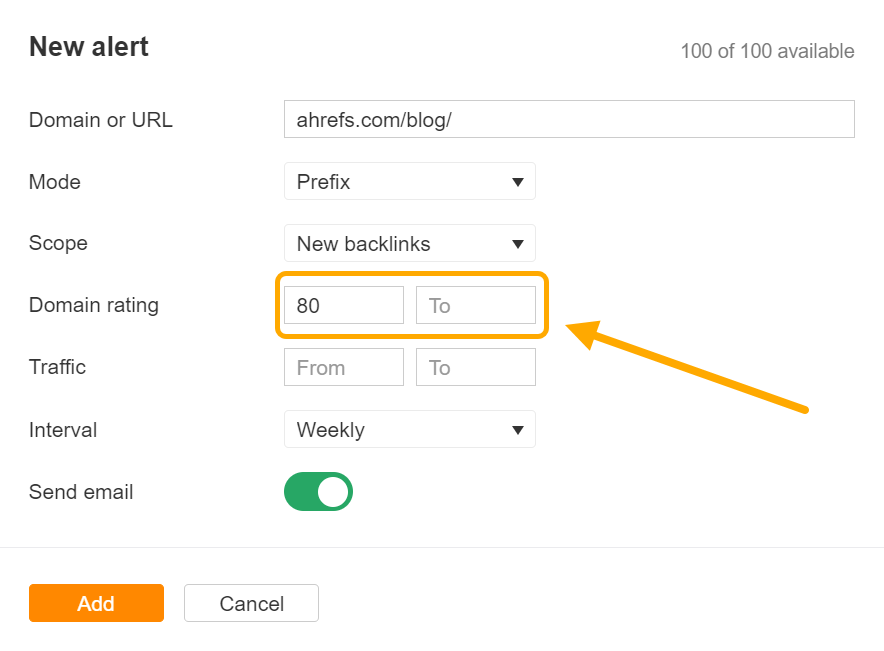Marketing is full of things that can be measured (known as metrics), but not all metrics make good key performance indicators.
To choose the right KPIs:
- Tailor them to your role. Different marketing roles need different levels of detail in their KPIs. An SEO lead might care about monthly backlink growth, but a CMO will care more about the sales revenue generated across all marketing efforts.
- Measure what you want to improve. Don’t spend energy tracking KPIs just for the sake of tracking them. Choose KPIs specifically to better understand the areas you most want to improve.
- Be realistic about what you can measure. Some KPIs sound great in theory but are almost impossible to measure in practice. Before committing to a KPI, make sure you can actually get the data you need and measure it consistently.
- Focus on KPIs that you can influence. Your KPIs should measure something that you can influence directly. “Net Promoter Score” is a great measure of how much people **** your product, but how useful is it for content marketers who don’t actually control the product?
- Keep it simple. You don’t need to track 37 marketing KPIs. A handful of KPIs per department is usually enough to make progress where it matters (in fact, many companies use one “north star” metric).
There are an almost infinite number of KPIs, often varying in small details (like how they’re measured, or subtle differences in definition). Many KPIs also have overlapping audiences (SEOs and content marketers may track very similar things).
But with those caveats, let’s talk through core marketing KPIs for common marketing roles—and how to calculate them.
These KPIs help marketing leaders—CMOs, VPs or directors, heads of marketing—report on the efficacy of marketing as a whole. They try to measure the impact of marketing in cold, hard dollar terms.
Most of these KPIs can be calculated for marketing as a whole, or for individual marketing channels (like content marketing or events). In fact, that’s the point: a big part of a marketing leader’s job is to compare the results from different marketing channels, and work out which perform best.
| KPI | In plain English… | The math… |
|---|---|---|
| ROMI (return on marketing investment) | How much does your marketing cost compared to how much money it generates? | = (revenue attributed to marketing spend – marketing spend) / marketing spend |
| LTV (lifetime value) | How much does an average customer spend with you across their whole relationship with your business? | = average monthly revenue per customer / average monthly churn rate |
| CAC (customer acquisition cost) | How much do you have to spend on marketing to get one new customer? | = total costs spent acquiring customers / number of customers acquired |
For many content marketers, the best KPI is also the simplest: publishing frequency. Focus on what you can control, work to publish more content each month, and other important metrics (like traffic) will follow after.
| KPI | In plain English… | The math… |
|---|---|---|
| Traffic growth | How many people visit your website? And how does that change over time? | = ((current month’s traffic − previous month’s traffic) / previous month’s traffic)×100 |
| Publishing frequency | How often do you publish blog posts, schedule social posts, or hold webinars? | = total number of published pieces / time period (e.g., posts per week or month) |
| First 30-days traffic | How many people visit a new page or post in the first 30-days since launching? | = count of unique visitors to the page or post within the first 30 days of its launch. |
Tip
How to estimate organic traffic growth
Google Analytics and other analytics tools will give you the data needed to measure traffic growth for websites you own. For other websites—like your competitors—you can use Ahrefs to estimate their organic traffic growth.
Head to Site Explorer, enter the website URL you’re interested in (setting the view to Path, Domain, or Subdomain, depending on which part of the website you’re analyzing), and choose the Monthly view for the Performance chart. Hover over the graph and you’ll see estimated organic traffic for each month.
Here, Clickup.com saw an estimated 645,000 organic pageviews in January:

Hovering over the next month, February’s organic traffic was an estimated 664,000 pageviews:

Using our formula for traffic growth rate, we can work out that Clickup’s organic traffic grew an estimated 3% between January and February ( (664234 - 645286) / 645286) * 100) = 2.94%).
You can also use the Portfolios feature to measure traffic growth to collections of specific URLs, like this portfolio of my published articles…

…allowing you to measure traffic growth by author, or topic, or content type:

Lead generation is all about turning anonymous visitors into recognisable, contactable leads, usually by capturing their email addresses. Most of their KPIs measure the quantity and quality of the leads they generate:
| KPI | In plain English… | The math… |
|---|---|---|
| SQLs (sales qualified leads) | How many leads have taken an action that indicates their desire to buy? | = count of leads that meet the sales-qualified criteria set by the organization. |
| MQLs (marketing qualified leads) | How many leads have interacted with your marketing but are not ready to buy? | = count of leads that meet the marketing-qualified criteria set by the organization. |
| Conversion rate | How often do your visitors buy, or request a demo, or start a free trial? | = (total number of conversions / total number of visitors or leads)×100 |
Most of these KPIs can be tracked across social media as a whole, but also on a per channel basis (for Twitter, and Instagram, and Facebook, and so on).
| KPI | In plain English… | The math… |
|---|---|---|
| Total followers | The total number of individuals following your social media profile or page. | = sum of all followers across specified social media platforms. |
| Total impressions | The total number of times your content was displayed to users. | = sum of all views or appearances of your content across platforms, regardless of clicks or engagement. |
| Follower growth rate | The rate at which your follower count is increasing over a specific time period. | = (number of new followers gained / number of followers at the start of the period) × 100 |
For search professionals, organic growth is the goal. These are some of the KPIs most commonly used to measure their progress and present their value to the rest of the company:
| KPI | In plain English… | The math… |
|---|---|---|
| Keyword rankings | Where do your pages rank in the search results for their target keyword? | No math needed—just use a rank tracker like Ahrefs rank tracker |
| Backlink growth | How often do other websites link to your website? | = (current month’s backlinks − previous month’s backlinks) / previous month’s backlinks)×100 |
| Organic Share of Voice | How visible are you in search results compared to your competitors? | No math needed—just use Ahrefs Share of Voice report (see below) |
tip
How to calculate share of voice for keywords
One of the best ways to measure organic share of voice (SOV) is to track the number of clicks your website receives from important keywords, relative to the clicks your competitors receive. To get set up, add a list of important keywords into Rank Tracker, head to the Competitors overview tab and add the URLs of your competitors’ websites.
You’ll see an estimate of your site’s share of the total available clicks for your given keywords, as well your competitors’ SOV, and recent trends in performance:

Traditional press is usually concerned with the number of press mentions generated by a campaign, but add digital PR into the mix, and backlinks become another primary goal. Daria Samokish, Ahrefs’ Head of PR, tracks KPIs like:
| KPI | In plain English… | The math… |
|---|---|---|
| Number of press mentions | How many news or media outlets referenced your latest campaign? | = count of distinct press or media mentions of the campaign across various platforms. |
| Number of campaign backlinks | How many websites linked back to your latest campaign? | = count of unique external web pages linking back to the campaign’s specific page or content. |
| Traffic spikes on launch day | How many people interact with your campaign the day it’s launched? | = count of visitors, clicks, or interactions on the campaign’s launch day. |
Tip
How to measure the impact of digital PR
Ahrefs’ Site Explorer makes it easy to see how a digital PR campaign translates into new links. Here’s an example from the launch of our search engine, Yep.com.
The Calendar view in Site Explorer shows a spike in new referring domains on June 4th 2022—the day of the press campaign—with 219 new referring domains registered (up from a daily average of 1–2 in May).

You can also use Ahrefs’ Alerts to get an automated notification whenever you gain a new link. In the example below, we’ll get a weekly notification summarising all new backlinks for ahrefs.com/blog/ from websites with a domain rating of 80 or above:

Shermin Lim, our Events & Marketing Manager, cares primarily about working out the return on investment from her online and in-person events, balancing the costs of the event and the potential gain from new leads and customers. Three of her core performance indicators are:
| KPI | In plain English… | The math… |
|---|---|---|
| Attendees | How many people attended the event? | = count of all individuals who registered and were marked present at the event. |
| NPS (Net Promoter Score) | Would attendees recommend the event to their friends and colleagues? | = % of promoters − % of detractors |
| New Sales Leads | How many attendees talked to the sales team about purchasing or upgrading? | = count of attendees who initiated a conversation or inquiry about purchasing or upgrading with the sales team. |
Paid marketing is as close to science as marketing tends to get, with a very clear (and measurable) relationship between the cost of an advert and the revenue it generates. But while paid marketing KPIs can get very mathsy, very quickly, there are three core metrics underpinning it all:
| KPI | In plain English… | The math… |
|---|---|---|
| ROAS (return on advertising spend) | How much money is this ad generating, relative to the amount that was spent on it? | = total conversion value / amount spent |
| CPC (cost per click) | How much does every advert click cost us? | = total cost of clicks / total number of clicks |
| CPM (cost per impression) | How much does every thousand views of this advert cost us? | = (total ad spend / total impressions ) ×1000 |
Final thoughts
Marketing KPIs can help you communicate your wins to bosses and teammates, pinpoint tactics that work well (and those that don’t), and provide a clear focal point for your marketing team to rally around.
But there’s a caveat to remember: don’t ignore marketing opportunities that don’t fit neatly into your KPIs.
Not every great marketing campaign can be easily measured. The goal of marketing is to grow your business. Use KPIs where they help… but don’t shy away from ignoring them on the rare occasions when they don’t.
Source link : Ahrefs.com
